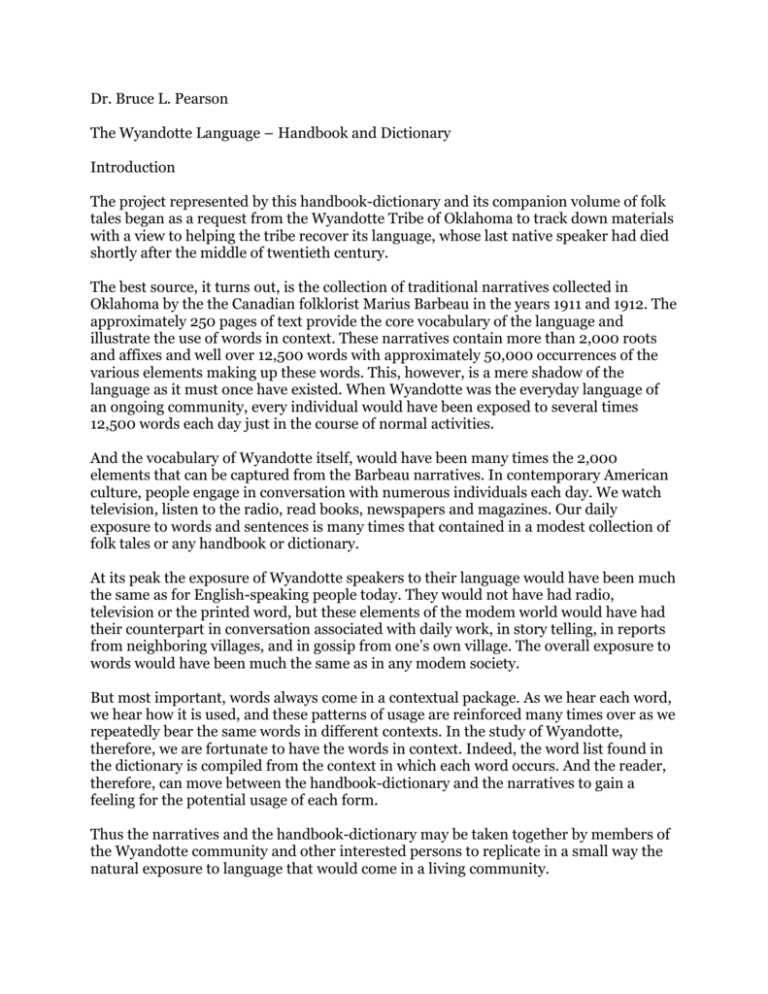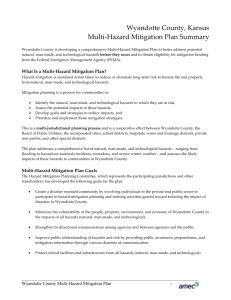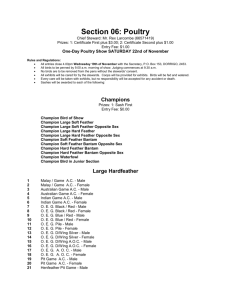Dr. Bruce L. Pearson The Wyandotte Language – Handbook and
advertisement

Dr. Bruce L. Pearson The Wyandotte Language – Handbook and Dictionary Introduction The project represented by this handbook-dictionary and its companion volume of folk tales began as a request from the Wyandotte Tribe of Oklahoma to track down materials with a view to helping the tribe recover its language, whose last native speaker had died shortly after the middle of twentieth century. The best source, it turns out, is the collection of traditional narratives collected in Oklahoma by the the Canadian folklorist Marius Barbeau in the years 1911 and 1912. The approximately 250 pages of text provide the core vocabulary of the language and illustrate the use of words in context. These narratives contain more than 2,000 roots and affixes and well over 12,500 words with approximately 50,000 occurrences of the various elements making up these words. This, however, is a mere shadow of the language as it must once have existed. When Wyandotte was the everyday language of an ongoing community, every individual would have been exposed to several times 12,500 words each day just in the course of normal activities. And the vocabulary of Wyandotte itself, would have been many times the 2,000 elements that can be captured from the Barbeau narratives. In contemporary American culture, people engage in conversation with numerous individuals each day. We watch television, listen to the radio, read books, newspapers and magazines. Our daily exposure to words and sentences is many times that contained in a modest collection of folk tales or any handbook or dictionary. At its peak the exposure of Wyandotte speakers to their language would have been much the same as for English-speaking people today. They would not have had radio, television or the printed word, but these elements of the modem world would have had their counterpart in conversation associated with daily work, in story telling, in reports from neighboring villages, and in gossip from one’s own village. The overall exposure to words would have been much the same as in any modem society. But most important, words always come in a contextual package. As we hear each word, we hear how it is used, and these patterns of usage are reinforced many times over as we repeatedly bear the same words in different contexts. In the study of Wyandotte, therefore, we are fortunate to have the words in context. Indeed, the word list found in the dictionary is compiled from the context in which each word occurs. And the reader, therefore, can move between the handbook-dictionary and the narratives to gain a feeling for the potential usage of each form. Thus the narratives and the handbook-dictionary may be taken together by members of the Wyandotte community and other interested persons to replicate in a small way the natural exposure to language that would come in a living community. Since the purpose of this project has been to capture, insofar as possible, the Wyandotte language for the benefit of the modern Wyandotte community, I have tried to tailor the presentation to the needs and interests of a community seeking to learn the language and depending on the written narratives and the handbook-dictionary as their sole exposure to the language. This is not as simple as one might suppose, however. There are numerous problems in interpreting Barbeau’s transcriptions. And there are similar problems in presenting a morphologically complex language in a format understandable to people who have long since abandoned this language in favor of English. Accordingly, I have departed from some practices found in other treatments of Iroquoian languages. I think these departures can be justified on the assumption that, if modern Wyandotte people were learning the language in Wyandotte-speaking households, they would make essentially the same assumptions about the structure of the language that are made here. Among other things, I have treated most junctural vowels as part of word roots rather than separate insertions. And, although nouns in Wyandotte are formed from verbs, I have chosen to recognized their function as nouns by labeling their prefixes and suffixes as though these forms are indeed nouns. In addition, some forms traditionally analyzed in Iroquoian languages as verbal prefixes have been treated here as separate words. Similarly, some elements traditionally analyzed as verbal suffixes are treated here as part of the verb root. I have adopted a conservative practice in the sense that I have tried to depend solely on evidence internal to the narratives in determining word structure. Thus if an element known to be a verbal suffix in a related language never occurs independently in the Barbeau narratives, it has seemed wise to regard it as part of the verb. When a similar element occurs freely with several verbs, it is recognized as an independent suffix. The result is shorter, relatively more transparent words, a practice that Barbeau himself sometimes adopted-although not in any consistent way. Wyandotte is of course slightly different from even closely related Iroquoian languages. This fact offers justification for analyzing morpheme structure (the internal composition of words) in ways that differ slightly from related languages. Moreover, it is a practice favored by the modern Wyandotte community of Oklahoma in their desire to develop a standardized form of the language. The problem of analyzing and transcribing a language that lacks an established writing tradition is one that linguists and the communities they serve must always wrestle with. If the results are not totally satisfactory, the fault rests more with me than with the Wyandotte community. In general, I have tried to avoid using abstract forms that must be processed by phonological rules in favor of the various concrete forms that actually occur. Thus it becomes necessary to recognize various forms meaning ‘self’ – ya’ t, a’ t, a’ ta – and so forth. But it has seemed wiser in dealing with another item to posit a single form -ate’ w(a)- ‘to escape” which becomes -ate’ m- when followed by a nasal suffix. I am guessing, rightly or wrongly, that this is the way the last generation of native Wyandotte speakers viewed their language. The goal has been to strive for a consistent representation for every item each time it occurs and, that failing, to provide an understandable account of the differences in terms of plausible pronunciation rules. I have preserved the essential phonetic symbols used in the Barbeau narratives inasmuch as any study of Oklahoma Wyandotte must be tied to these narratives. Thus the apostrophe (’) is used to represent the glottal stop rather than the official symbol (ʔ ) of the International Phonetic Alphabet. Similarly, I have used /E/ to represent the nasalized vowel that many Iroquoianists represent with the symbol /ę/. In addition, I have substituted modern /š/ and /ž/ for the symbols /c/ and /j/ use by Barbeau and others in the early twentieth century. In general I have replaced all secondary nasalized vowels (that is, those vowels that have acquired nasalization from an adjacent sound) by plain vowels. The principal exception has been /ą/ which is retained in the various forms meaning no, not and in a few cases where its retention seemed a useful way to distinguish forms that would otherwise be homophonous. Many forms are presented as ending in a final parernthesized a, which serves as a transition sound if followed by a unit beginning with a consonant but is deleted if followed by a vowel. My reasoning is that this approach is more economical than inserting a vowel as a separate unit, even though this approach is contrary to the preference of many other Iroquoianists. I have also made a graphic distinction between a’- FACTUAL and a- OPTATIVE even though the two forms were often homophonous in the pronunciation of early twentieth century speakers. The two forms carry different meanings, and a graphic distinction is useful in the same way that to, two and two are distinguished in the standard writing system of English. –Bruce L. Pearson Dr. Bruce L. Pearson The Wyandotte Language – Handbook and Dictionary 1 The Wyandotte Language §1.1 History. Wyandotte is a Northern Iroquoian language of the Huron-Tionantati group. In the early 1600s, peoples speaking languages belonging to this group occupied a region in North America southeast of Georgian Bay, extending west to Lake Huron, south to Lake Erie and into adjacent portions of what is now New York, Pennsylvania and Ohio. The name, sometimes given Wyandot or Wendat, actually comes from Wandat, the term used for both the people and the language. The name, commonly translated as “the people,” comes from the third person prefix wa- (’they’) and the root (n)dat(a)- from earlier -nat(a)- meaning to have a village or settlement. It is frequently translated as “the villagers.” The Huron confederacy, composed of five tribes living in close proximity and occupying close to twenty villages on Georgian Bay in present-day Canada, is thought to have been formed about the year 1440. Related tribes, not part of the Huron confederacy, lived nearby. To the southwest, on the eastern shore of Lake Huron, nine villages were occupied by a people called Tionantati or Petun, famous for their tobacco production. Eastward toward the Five Nations were the Neutrals or Atiwandaronk and the closely related Wenro, who lived in a confederacy containing forty villages along the northern shore of Lake Erie and the southern shore of Lake Ontario. Farther east toward the western border of the Five Nations and bounded to the south by the Ohio River, were the Erie or Kahkwah, known also as the Cat Nation. The tribes mentioned here spoke related languages and may also have been related to the St. Lawrence Valley Iroquois, although next to nothing is known about this group, which lost its separate identity quite early. With the exception of seventeenth century Huron and twentieth century Wyandotte, these languages are poorly documented although existing evidence indicates they can all be classed as belonging to the greater Huron group of Northern Iroquoian languages. The name Huron itself comes from a French term that originally meant “ruffian.” Although this term has gained respectability over the years, the preferred self designation remains Wandat. The Five Nations of central New York-Seneca, Cayuga, Onondaga, Oneida and Mohawk –make up the lroquois-Kwedech group of Northern lroquoian languages, to which is also related Susquehannock, spoken formerly in Pennsylvania, along with Tuscarora and Nottowa, spoken at the time of European contact in coastal Virginia and North Carolina. A Southern Iroquoian group consisting of Cherokee was spoken in the upland regions of the Carolinas, Tennessee, Georgia and Alabama. This language remains in use among a group still living in North Carolina and a larger group now located in Oklahoma. Of the northern group, Mohawk is the only language with a substantial number of speakers today. Unfortunately, linguistic relatedness did not ensure peaceful relations among the Huron and Five Nations people. Conflicts arose over the fur trade, stemming in large part from the Huron alliance with the French and the Five Nations alliance with the English. As a result, the people now known as Wyandotte came together by the end of the seventeenth century after the Neutrals broke off relations with their Wenro confederates in 1639 and the Eries moved into Wenro territory. This forced the Wenro to abandon their villages, some of them settling with the Neutrals and others migrating to live under the protection of the Hurons. 2 In 1649, after suffering great losses from smallpox and wars with the Five Nations, the Hurons abandoned their villages on Georgian Bay. Most dispersed among other Iroquois tribes and the Ottawa, an Algonkian-speaking group, and eventually merged with their host tribes. Two groups, however-one in Canada and one in the United States – continue to maintain their identity as Wandat people. Both originally spoke dialects of the same language although those living in Canada eventually adopted French and those in the United States now speak English. The earlier language, termed Huron, is known from the grammars and dictionaries compiled by French missionaries in the seventeenth and eighteenth centuries. One group, calling themselves Wendat (spelled differently but pronounced the same as Wandat), eventually settled at Lorette Mission on the outskirts of Quebec City. Wyandotte, as documented in the early twentieth century in northeastern Oklahoma, shows similarity to Huron but should nonetheless be regarded as a separate language. Individual words are often different in form, and grammatical patterns also differ from those described by the early missionaries. The Wyandottes now living in the United States are descended from Huron bands, especially the Petun, who remained in the west rather than seeking refuge in Quebec. The group included the Atignawantan, one of the tribes making up the Huron Confederacy who settled with the Tionantati. In the 1650s the Eries and the Neutrals were defeated in a war with the Seneca and consequently joined the Tionantati and remnant groups of Huron living among them. It is this combination of related people, once members of a powerful confederacy but ultimately reduced in both strength and numbers by disease and the aggression of more powerful neighbors, that eventually became known as the Wyandotte. In 1701 the Wyandotte settled in Sandwich, Ontario. Some eventually migrated to Ohio, then to Kansas, and finally to Oklahoma, where the language remained spoken into the early years of the twentieth century. Several factors account for the differences between Huron and Wyandotte. For one thing, two different time periods are involved in the documentation of the languages. All languages undergo change with the passage of time, and language change is often accelerated during periods of rapid social change such as marked the period of European contact, subsequent warfare, relocation of refugee populations, and realignment of peoples. Thus it is no surprise that extensive changes in vocabulary and pronunciation should occur by the time Wyandotte was documented as an Independent language. Indeed, Wyandotte may already have had status as a distinct dialect within the Huron confederation by the time Huron was being documented by missionaries. And, as chance would have it, the Wyandotte dialect rather than Huron was carried to Oklahoma. A second possible factor is that the distinct groups that merged to form the Wyandotte people brought together several dialects that were already somewhat varied and thus different from the dialect known to the missionaries as Huron. Probably both developments contributed in varying degrees. The present book is based primarily on forty Wyandotte stories collected in Oklahoma by Marius Barbeau in the years 1911 and 1912 and published in 1960. A more complete account of the available resources for studying the Wyandotte language, as well as methodology used in compiling this book is given in §1.5 and in a Bibliography at the end of the book. §1.2 Pronunciation of consonants. Language is a system of human communication has on speech sounds. Writing is so widely used in modem technological societies that it often seems the primary form of language; but it is basically a way of representing speech through written symbols. This is true of Wyandotte, just as it is true of all other languages. Thus it is necessary to approach Wyandotte in terms of its speech sounds. 3 Wyandotte pronunciation is not particularly difficult. The sound system uses fourteen consonants and seven vowels. This is less than the 24 consonants and 14 vowels of English, but since not all of these sounds are the same as those found in English, some may seem strange at first The consonants can be arranged as in Figure 1-1 which follows. The arrangement is linguistically significant, but the terms used in describing the sounds are not important in themselves. All terms are explained, however, in the Glossary-Index at the end of the book. STOPS: labil alveolar (p) t d FRICATIVES: NASALS: LIQUID: s m palatal š ž n r velar glottal k g ʔ h GLIDES: w y Figure 1-1. Wyandotte Consonants. Most of the phonetic symbols-eleven of the fourteen, in fact-represent exactly the sounds a speaker of English would expect. Only three symbols are unfamiliar, and these are presented in Figure 1-2 below. Of these three sounds; only /š/ has a commonly accepted English spelling. The other sounds occur in English but have no standardized spelling. The one sound that is most likely to cause problems is the glottal stop, which is best described as the cough-like sound in the negative expression “uh-uh.” (Sounds under discussion in this book are enclosed in slashes as /š/ above. Letters used in spellings will be printed in italic type.) Phonetic Dictionary English Wyandotte Wyandotte Name symbol spelling example example meaning ofletter Phonetic symbol ʔ š ž Dictionary spelling ’ š ž English example uh-uh shoe measure Wyandotte Wyandotte example meaning ą’ ą no! yušahteh horse žamȩ hs it happens Name of letter glottal stop s-wedge z-wedge Figure 1-2. Spelling of Wyandotte Consonants. The official linguistic symbol for glottal stop looks something like a question mark (ʔ ), but common practice is to represent this sound using an apostrophe (’) –the practice that will be followed in this book. Although this sound occurs in English, its status is marginal. Conscious effort will probably be required to produce the sound at will. The status of /p/ is special. It does not occur in native Wandat words. However, it occurs in one word borrowed into the language. Similar observations can be made, not so much of other individual sounds, but of the sequences in which they occur. English does not normally permit vowels to occur in sequence, but 4 vowel sequences occasionally occur in Wyandotte. The sound represented by h often occurs before other consonants in Wyandotte, whereas in English this sound can occur only at the beginning of a word or syllable. Similarly, when h follows another consonant in Wyandotte, it represents a separate sound. Thus sequences of sh or th should not be interpreted as spellings for a single sound, as would be the case in English. Other sequences like ts are common in Wyandotte, whereas in English this sequence occurs only in specialized words like itsi-bitsi or at the end of words like hats. §1.3 Pronunciation of vowels. Wyandotte has four plain vowels and three nasalized vowels, which can be arranged in a table as shown in Figure 1-3 below. The arrangement corresponds roughly to the placement of the tongue in the oral cavity as each sound is pronounced. Thus Iii can be described as a high front vowel because the arch of the tongue is high and is near the front of the mouth. Similarly, 1f:1 can be described as a low front nasal vowel,and so forth. front central back high i u mid e ǫ low ę ą a nasalized i as in machine e as in weigh, get a as in father u as in super ȩ as in man, men ǫ as in know ą as in none Figure 1-3. Wyandotte Vowels. The four plain vowels are all sounds that occur in English and should present no problems. In each case the phonetic symbol represents a single sound, and each sound is always represented by the same symbol. The variation noted for the sounds /e/ and /ę/ would not strike a speaker of Wyandotte as significant because the crucial difference is whether the vowel is nasalized or not. The English example given first is the more common variant in each case. The three nasalized vowels are similar to the vowels in the English words given as examples. In the English examples the nasal passageway remains open, creating nasal resonance in anticipation of the nasal consonant. In Wyandotte, however, the nasal consonant that originally caused nasalization of the vowel has generally disappeared. (Nasal vowels occur in French, making these sounds easy for anyone familiar with French.) To practice nasal vowels, one can begin by humming and then, while continuing a humming sound with its nasal resonance, produce desired vowel sound. The hook under nasal vowels can be imagined as a stylized nose (∠ ) to remember that the sound is made partly through the nose. Of the the nasalized vowels, /ą/ is fairly infrequent and few words depend crucially on this sound. 5 If the sounds of Wyandotte seem intimidating at first, modem day members of the Wyandotte community can take consolation in two significant facts. First, all languages undergo constant change. The rate of change is normally so gradual as to be unnoticed from one generation to the next, but it is always in progress. Over the years Wyandotte has diverged considerably from Huron and the other Iroquoian languages. Second, spoken Wyandotte has not been in common use for a number of years. Consequently, as modem members of the Wyandotte community revive the language, any individual’s claim to authentic pronunciation is as good as anyone else’s. The vowel system of Wyandotte is similar to that of the other Northern Iroquoian languages, which commonly have four plain vowels, usually represented /i, e, a, 0/, and two nasalized vowels, represented as /ę/ and /ǫ /. The plain vowels contrast along two dimensions-front versus back, and high versus low. The two nasalized vowels differ on the front-back dimension but are of intermediate height. In Wyandotte, earlier /o/ has developed into /u/ while the nasalized vowels /ȩ / and /ǫ / seem to have remained unchanged. Wyandotte has also departed from the other languages by adding a third nasalized vowel /ą/, which arose whenever plain /a/ was adjacent to another nasalized sound. The four plain vowels continue to contrast as before, even though earlier /o/ is now represented as /u/. Of the nasalized vowels, /ȩ / and /ǫ / remain intermediate in height while the newly added /ą/ is distinctly lower, still phonetically similar to /a/. In the presentation of Wyandotte in this book, every effort has been made to distinguish the seven vowels as clearly as possible and at the same time remain true to the facts of the language. Thus /u/ and /ǫ / are distinguished both by different letters (indicating phonetic quality) and by the hook (indicating nasalization). The phonetic distinction between /e/ and /ȩ /, although less distinct in pronunciation, is also represented by different letters as well as by the nasal hook. The distinction between /a/ and /ą/ is represented only by the hook. These practices will contribute to ease in recognizing printed forms and pronouncing them. Students of Wyandotte can easily print the phonetic symbols when writing by hand, and phonetic fonts are readily available for word processors. Since most typewriters lack the script letter /ę/, the character /ę/ can be written as /e/ and a nasal hook added by hand. Similarly, symbols for the sounds /š/ and /ž/ can have the wedge added by hand if it is not available on a typewriter. §1.4 Word structure. In general, Wyandotte words end in a consonant, often h or a glottal stop. However, this sound is sometimes lost in connected speech. Word stress commonly comes on the next to last syllable, but for speakers in the early 20th century stress occasionally came on the final syllable or shifted to a syllable near the beginning of a word in accord with well established rules. Modern speakers prefer a regular pattern of stress on the next to last syllable or a pattern of stress on major components of complex words. Stress patterns are discussed more fully in §12.30. Verbs are central in Wyandotte and other Iroquoian languages. Typically, a verb consists of three elements: (1) a VERB ROOT (denoted by a gloss giving its meaning), which conveys the basic action or state expressed by the verb, (2) a PRONOMINAL PREFIX (abbreviated pro), which identifies the person associated with the verb root, and (3) a SUFFIX (abbreviated suf), which indicates the status of the action or state expressed by the verb – for example, whether the event is continuing, is a one-time occurrence, or the like. Many verb roots are expanded to form a verb BASE. This may consist of two verb roots or a noun and verb together (similar to babysit in English), and this base may be supplemented by additional prefixes and suffixes providing further information about the manner in which the action is accomplished – the kind of information that would be provided by adverbial phrases in a 6 language like English. The expanded base becomes a STEM, to which the prefixes and suffixes described in the preceding paragraph must still be attached to form a COMPLETE VERB as explained in Chapter 9. The overall grammar, while fairly complex, will be presented in the following chapters in a step-by-step fashion to make assimilation of the details as simple and straightforward as possible. §1.5 Methodology, resources and personnel. As already noted, this book is based on forty narratives collected in Oklahoma in 1911 and 1912 by Marius Barbeau and published much later, in 1960. These texts constitute almost the total surviving record of the language. The Barbeau texts are printed in double columns, the left-hand column in Wyandotte and the right-hand column in English. Each Wyandotte word is numbered, and these numbers correspond to the English word-by-word translation in the righthand column. Readers who wish to refer to the Barbeau texts will find parenthesized references like (137.18), in which the first number refers to the page and the second to the numbered word on that page. The Barbeau collection begins with a short introduction giving biographical sketches of the five individuals who provided the narratives and four others who helped with translations. This is followed by free translations of the forty stories, a key to the phonetic symbols, and the Wyandotte texts with word-by-word translations. The texts constitute the main part of the volume, about 250 pages in all. Additional material,including photographs of the Wyandotte story tellers, fills out the remaining pages. The Wyandotte texts are reproduced from a handwritten phonetic manuscript, with the result that the form of some letters is different from the standard typeface used in this book. Two other problems should be noted. On one hand, some of the transcriptions include phonetic details that should probably be disregarded, much like the English pronunciation of something as somepthing. On the other hand, some transcriptions omit details that are normally expected, much as in the casual pronunciation of suppose as s’pose. The forms presented in this book attempt to normalize such variants so that words are represented as having a consistent form, as preferred by modern members of the Wyandotte community. The goal of representing each word consistently is complicated, however, by the existence of many Wyandotte pronunciation rules that modify words in sometimes drastic ways. These cannot be ignored but must be introduced as necessary. Throughout the book, an effort is made to analyze the grammatical structure of each word and interpret the meaning as accurately as possible. Thus the careful reader will find many details that differ from Barbeau’s earlier analysis. These departures from Barbeau are clearly warranted by the linguistic facts. Still, the present volume is incomplete and probably contains many errors. Although these errors can be corrected as work progresses, the description of a language no longer in everyday use will always be limited by the available record. In the case of Wyandotte, Barbeau’s texts can be supplemented by references to Wyandotte in other published articles and by word lists preserved by the Wyandotte Tribe in Oklahoma. These word lists often present two or more words for a given meaning, strongly suggesting that the language now known as Wyandotte was a merger of several distinct dialects, each with its own vocabulary. As the groups merged into a single speech community, different words to express the same meaning came to exist side by side. Similar developments have occurred in the recorded history of other languages. After the conquest of England by French-speaking Normans in 1066, many French words were added to the English vocabulary. Thus native English stop exists alongside French desist. In this case, however stop remains the everyday word and desist is used in more formal situations. Available evidence is unclear as to whether Wyandotte synonyms became differentiated in a similar way. 7 As the modern Wyandotte community seeks to revive the language, it is already expanding the documented vocabulary by extending the domain of existing terms. For example, the term drahtah ‘leaf’ is currently used in language classes for ‘page.’ It seems likely that other processes of word coinage and borrowing will also come into play as members of the community renew ties with other Iroquoian tribes and, as necessary, incorporate English borrowings into the vocabulary. Wallace Chafe and Marianne Mithune of the University of California at Santa Barbara offered useful suggestions and assistance as the project got under way, as did Roy Wright of Université Laval. Research assistance was provided by Richard Norwood, and additional assistance as provided by Cathleen Bridgeman, Steven Gross, Newton Hamlin, Eunita Ochola, and Julia Richardson, all of the University of South Carolina. The work was partially supported by a grant from the University of South Carolina Research and Productive Scholarship Fund. A detailed list of resources available for the study of Wyandotte and related languages is given preceding the Glossary-Index at the back of the book. The narratives collected by Barbeau were provided by five elderly speakers of Wyandotte. In general, their usage of the language is consistent. For convenience in noting variation from one speaker to another, individuals are identified by initials. Following is a list of the story tellers, together with other relevant information: Catherine Johnson (CJ), age 60 in 1911. Mrs. Johnson (birth name, Coon) was the narrator for thirty stories in the collection, accounting for 75 percent of the material. Barbeau describes her as speaking Wyandotte almost exclusively but having to confer with acquaintances to recall details of stories. Smith Nichols (SN), age 83. As the oldest of the story tellers, Mr. Nichols presumably represents the most conservative usage. Barbeau describes him as having extensive knowledge of the past. He provided five stories, accounting for 13 percent of the total material. John Kayrahoo (JK), age 72. Mr. Kayrahoo, according to Barbeau, spoke only Wyandotte. He provided two stories, accounting for about eight percent of the material. Star Young (SY), age 65. Mr. Young (proper name Hiram) provided two fairly short stories, accounting for about three percent of the material. Mary McKee (MM), age 73. Miss McKee, a resident of Essex County, Ontario, provided a single story roughly one percent of the total material. Translations of the stories were worked out by Barbeau with the help of the story tellers and four other individuals: Allen Johnson (the son of Catherine Johnson), Eldredge H. Brown, Mary Kelley, and Henry Stand. As already noted, the grammatical description presented in the present volume draws on Barbeau’s analysis but is informed by additional material and analytical insights not available earlier.






